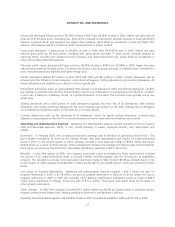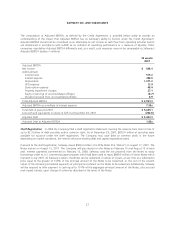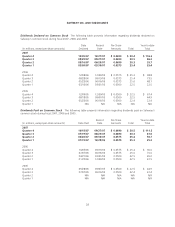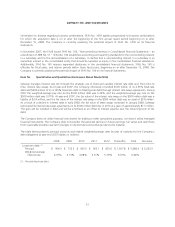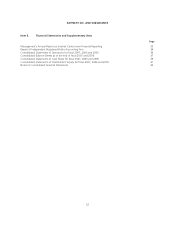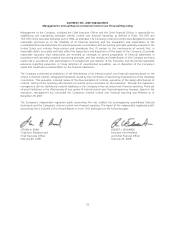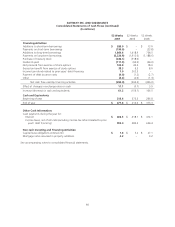Safeway 2007 Annual Report Download - page 52
Download and view the complete annual report
Please find page 52 of the 2007 Safeway annual report below. You can navigate through the pages in the report by either clicking on the pages listed below, or by using the keyword search tool below to find specific information within the annual report.SAFEWAY INC. AND SUBSIDIARIES
Off-Balance Sheet Arrangements
Guarantees The Company is party to a variety of contractual agreements under which it may be obligated to indemnify
the other party for certain matters. These contracts primarily relate to the Company’s commercial contracts, operating
leases and other real estate contracts, trademarks, intellectual property, financial agreements and various other
agreements. Under these agreements, the Company may provide certain routine indemnifications relating to
representations and warranties (for example, ownership of assets, environmental or tax indemnifications) or personal
injury matters. The terms of these indemnifications range in duration and may not be explicitly defined. Historically,
Safeway has not made significant payments for these indemnifications. The Company believes that if it were to incur a
loss in any of these matters, the loss would not have a material effect on the Company’s financial statements.
Letters of Credit The Company had letters of credit of $58.9 million outstanding at year-end 2007. The letters of
credit are maintained primarily to support performance, payment, deposit or surety obligations of the Company. The
Company pays commissions ranging from 0.15% to 1.00% on the face amount of the letters of credit.
Interest Rate Swap Agreements The Company has, from time to time, entered into interest rate swap agreements to
change its portfolio mix of fixed - and floating-rate debt to more desirable levels. Interest rate swap agreements involve
the exchange with a counterparty of fixed - and floating-rate interest payments periodically over the life of the
agreements without exchange of the underlying notional principal amounts. The differential to be paid or received is
recognized over the life of the agreements as an adjustment to interest expense. The Company’s counterparties have
been major financial institutions. As of year-end 2007, the Company effectively converted $500 million of its 4.95%
fixed-rate debt due in 2010 and $300 million of its 4.125% fixed-rate debt due in 2008 to floating-rate debt through
interest rate swap agreements. In January 2008, Safeway terminated its interest rate swap agreements on its $500 million
debt at a gain of approximately $7.5 million. This gain will be included in debt and will be amortized as an offset to
interest expense over the remaining term of the debt.
Energy Contracts The Company has entered into contracts to purchase electricity and natural gas at fixed prices for a
portion of its energy needs. Safeway expects to take delivery of the electricity and natural gas in the normal course of
business, and these contracts are not net settled. Since these contracts qualify for the normal purchase exception of SFAS
No. 133, “Accounting for Derivative Instruments and Hedging Activities,” they are not marked to market. Energy
purchased under these contracts is expensed as delivered.
New Accounting Standards
In September 2006, the Financial Accounting Standards Board (“FASB”) issued SFAS No. 157, “Fair Value Measurement.”
SFAS No. 157 defines and establishes a framework for measuring fair value in generally accepted accounting principles,
and expands related disclosures. This Statement does not require any new fair value measurements. SFAS No. 157 is
effective for fiscal years beginning after November 15, 2007. SFAS No. 157 is not expected to have a material effect on
the Company’s financial statements.
In February 2007, the FASB issued SFAS No. 159, “The Fair Value Option for Financial Assets and Financial Liabilities–
Including an amendment of FASB Statement No. 115.” SFAS No. 159 permits companies to measure many financial
instruments and certain other items at fair value at specified election dates. Unrealized gains and losses on these items
will be reported in earnings at each subsequent reporting date. The fair value option may be applied instrument by
instrument (with a few exceptions), is irrevocable and is applied only to entire instruments and not to portions of
instruments. SFAS No. 159 is effective for fiscal years beginning after November 15, 2007. The Company is currently
assessing the potential impact of SFAS No. 159 on its financial statements.
In December 2007, the FASB issued SFAS No. 141 (revised 2007), “Business Combinations” (SFAS No. 141R”). SFAS
No. 141R established principles and requirements for how an entity which obtains control of one or more businesses
(1) recognizes and measures the identifiable assets acquired, the liabilities assumed and any noncontrolling interest in the
acquiree, (2) recognizes and measures the goodwill acquired in the business combination and (3) determines what
30




